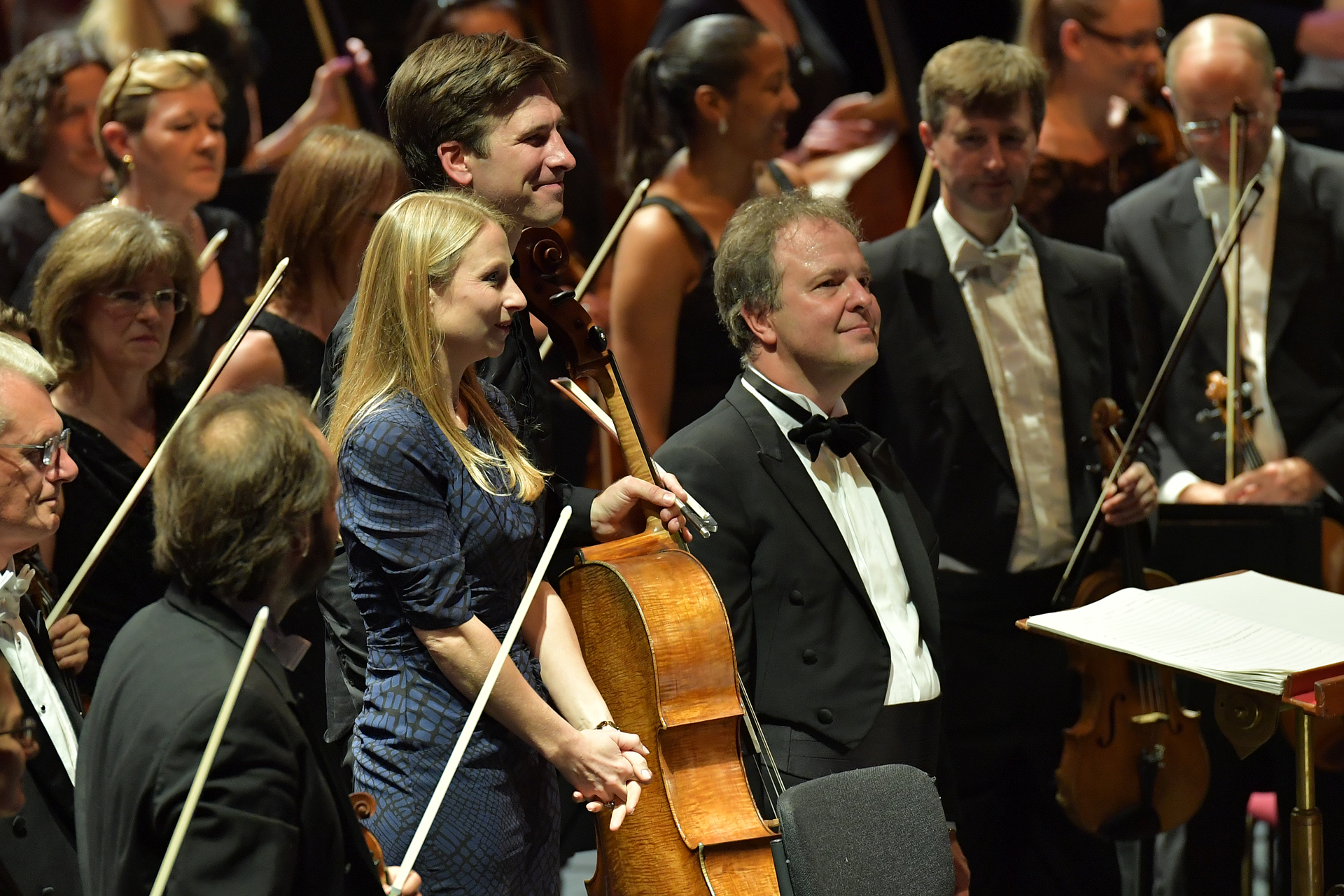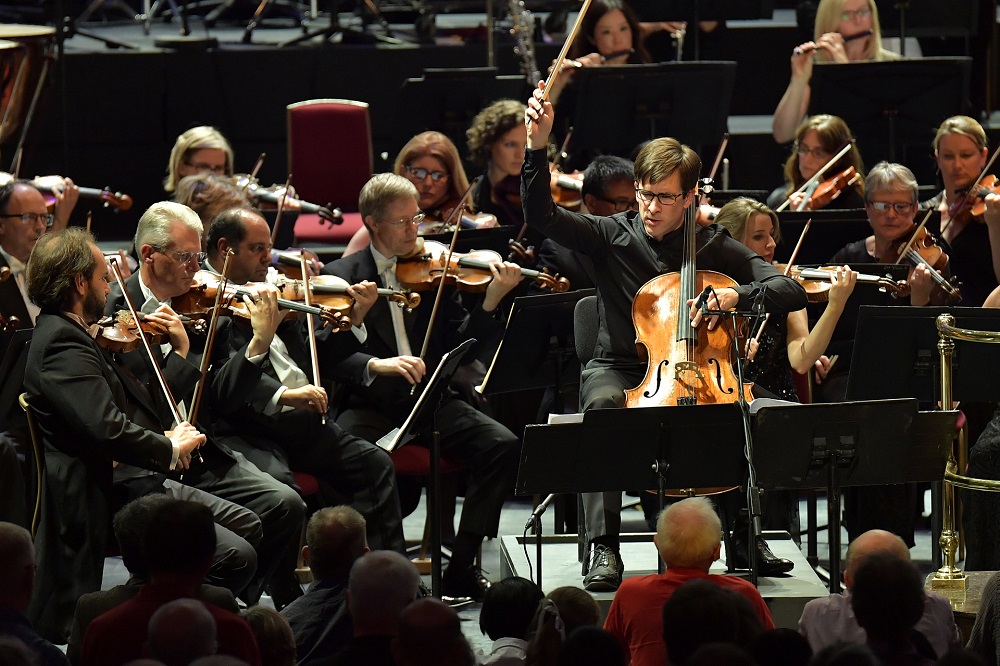Prom 39: Johnston, BBCSO, Oramo | reviews, news & interviews
Prom 39: Johnston, BBCSO, Oramo
Prom 39: Johnston, BBCSO, Oramo
Mahler with beauty and natural flow, and a premiere with a problem
The mid-way point of the BBC Proms has just passed. Attention during the eight-week season will inevitably tend to gravitate towards the novelties, “events” and one-offs, but one pre-condition for the summer to be going well is that the Proms' backbone ensemble, the BBC Symphony Orchestra, which plays no fewer than 12 of the concerts, has to be on good form.
The main work on offer, Mahler’s Fifth Symphony, showed the orchestra in all departments thriving under Sakari Oramo’s direction in the core repertoire which fits – and also fills – the hall. Oramo’s reading of the work was a delight. He constantly brought out its shape and organic, natural flow. He didn’t overdo the grand guignol or the more depressive side; attention was placed above all on order and beauty.
Serenity and elegance are clearly to be found in the famous Adagietto, which received an exquisitely shaped performance, but Oramo was also finding such traits in far less obvious places. In the second, “stormy” movement, it was – unusually – the two lyrical sections near the beginning and at the end which really stood out. The molto cantando cello melody with its rising minor sixths gave the section led by Susan Monks the chance to shine and they absolutely took it, playing from front desk to back desk as a proper unified ensemble.
In Mahler’s typically long lines, Oramo is constantly encouraging, asking for more from the orchestra, and getting back exactly what he wants from soloists and whole sections. One typically generous, inviting Oramo gesture is to punch empty air on the beat before a cue, which gives the entering soloist a precise springboard to work from, and ensures precision, confidence and characterful playing every time. He used it to great effect, for example, in the cues for trumpet, for horn, and for the flutes in the closing, fading section of that second movement. The wonderful clarity of the Oramo upbeat was bringing back very happy memories of the late Colin Davis and his stewardship of this same orchestra almost half a century ago.
The composer also knows the cello well, having initially entered Birmingham Conservatoire as a student on the instrument. The main problem – from where I sat – was that cello soloist Guy Johnston’s busy part (the cellist, pictured below), full of argument and complexity was completely inaudible in the hall for long sections of the work. The work was described in the composer's programme note as “an abstract reflection on the situation [in Syria] and on conflict in its wider sense”. The only message I was getting was that reasoned argument will be shouted down by people (a 12-member brass section playing at full tilt, for example) who might have less sophisticated arguments but can simply shout louder. 
This is one of those Haydn symphonies in which every member of the first violin section needs to step forward and be counted, and carry the melodic line. Full marks all round, they came across as a proper section throughout. The lone bassoon in the Haydn, unnamed in the programme and presumably a late replacement, also made her highly effective and unobtrusive contributions to the texture. Orchestra and conductor fully deserved the vociferous applause lasting several minutes which they received at the end of the evening.
rating
Share this article
The future of Arts Journalism
You can stop theartsdesk.com closing!
We urgently need financing to survive. Our fundraising drive has thus far raised £49,000 but we need to reach £100,000 or we will be forced to close. Please contribute here: https://gofund.me/c3f6033d
And if you can forward this information to anyone who might assist, we’d be grateful.

Subscribe to theartsdesk.com
Thank you for continuing to read our work on theartsdesk.com. For unlimited access to every article in its entirety, including our archive of more than 15,000 pieces, we're asking for £5 per month or £40 per year. We feel it's a very good deal, and hope you do too.
To take a subscription now simply click here.
And if you're looking for that extra gift for a friend or family member, why not treat them to a theartsdesk.com gift subscription?
more Classical music
 Jakub Hrůša and Friends in Concert, Royal Opera review - fleshcreep in two uneven halves
Bartók kept short, and a sprawling Dvořák choral ballad done as well as it could be
Jakub Hrůša and Friends in Concert, Royal Opera review - fleshcreep in two uneven halves
Bartók kept short, and a sprawling Dvořák choral ballad done as well as it could be
 Monteverdi Choir, ORR, Heras-Casado, St Martin-in-the-Fields review - flames of joy and sorrow
First-rate soloists, choir and orchestra unite in a blazing Mozart Requiem
Monteverdi Choir, ORR, Heras-Casado, St Martin-in-the-Fields review - flames of joy and sorrow
First-rate soloists, choir and orchestra unite in a blazing Mozart Requiem
 Cho, LSO, Pappano, Barbican review - finely-focused stormy weather
Chameleonic Seong-Jin Cho is a match for the fine-tuning of the LSO’s Chief Conductor
Cho, LSO, Pappano, Barbican review - finely-focused stormy weather
Chameleonic Seong-Jin Cho is a match for the fine-tuning of the LSO’s Chief Conductor
 Classical CDs: Shrouds, silhouettes and superstition
Cello concertos, choral collections and a stunning tribute to a contemporary giant
Classical CDs: Shrouds, silhouettes and superstition
Cello concertos, choral collections and a stunning tribute to a contemporary giant
 Appl, Levickis, Wigmore Hall review - fun to the fore in cabaret and show songs
A relaxed evening of light-hearted fare, with the accordion offering unusual colours
Appl, Levickis, Wigmore Hall review - fun to the fore in cabaret and show songs
A relaxed evening of light-hearted fare, with the accordion offering unusual colours
 Lammermuir Festival 2025, Part 2 review - from the soaringly sublime to the zoologically ridiculous
Bigger than ever, and the quality remains astonishingly high
Lammermuir Festival 2025, Part 2 review - from the soaringly sublime to the zoologically ridiculous
Bigger than ever, and the quality remains astonishingly high
 BBC Proms: Ehnes, Sinfonia of London, Wilson review - aspects of love
Sensuous Ravel, and bittersweet Bernstein, on an amorous evening
BBC Proms: Ehnes, Sinfonia of London, Wilson review - aspects of love
Sensuous Ravel, and bittersweet Bernstein, on an amorous evening
 Presteigne Festival 2025 review - new music is centre stage in the Welsh Marches
Music by 30 living composers, with Eleanor Alberga topping the bill
Presteigne Festival 2025 review - new music is centre stage in the Welsh Marches
Music by 30 living composers, with Eleanor Alberga topping the bill
 Lammermuir Festival 2025 review - music with soul from the heart of East Lothian
Baroque splendour, and chamber-ensemble drama, amid history-haunted lands
Lammermuir Festival 2025 review - music with soul from the heart of East Lothian
Baroque splendour, and chamber-ensemble drama, amid history-haunted lands
 BBC Proms: Steinbacher, RPO, Petrenko / Sternath, BBCSO, Oramo review - double-bill mixed bag
Young pianist shines in Grieg but Bliss’s portentous cantata disappoints
BBC Proms: Steinbacher, RPO, Petrenko / Sternath, BBCSO, Oramo review - double-bill mixed bag
Young pianist shines in Grieg but Bliss’s portentous cantata disappoints
 theartsdesk at the Lahti Sibelius Festival - early epics by the Finnish master in context
Finnish heroes meet their Austro-German counterparts in breathtaking interpretations
theartsdesk at the Lahti Sibelius Festival - early epics by the Finnish master in context
Finnish heroes meet their Austro-German counterparts in breathtaking interpretations
 Classical CDs: Sleigh rides, pancakes and cigars
Two big boxes, plus new music for brass and a pair of clarinet concertos
Classical CDs: Sleigh rides, pancakes and cigars
Two big boxes, plus new music for brass and a pair of clarinet concertos

Add comment